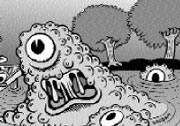You’ve gotta admire the often-toxic single-celled organisms called cyanobacteria or, misleadingly, “blue-green algae.” In their 3 billion years on earth, cyanobacteria have outlasted trilobytes, dinosaurs, mastodons, dot-com millionaires, and untold other less-fit organisms. So it’s no surprise that they’ve foiled the efforts of Seattle Parks and Recreation to purge them from the long-suffering urban pond named after them—Green Lake.
Monday, Aug. 5, the Parks Department closed Green Lake to swimming, windsurfing, and other get-wet sports after routine testing found microcystin, a potent liver and nerve toxin produced by a cyanobacteria, at 1.3 times the maximum level the World Health Organization (WHO) allows in drinking water. (The lake water’s not a water source, but dogs lap it up and swimming tots accidentally gulp it.) It extended the closure after follow-up tests found up to 1.8 times the WHO limit. The way the Parks Department tells it, you might think the bloom that prompted this is a new, or at least seasonal, event. “When nutrients are plentiful, the weather is warm, and the lake is calm,” reads a closure announcement, “the conditions are right for an algae bloom to take place.”
But the stuff now blooms year-round, according to King County limnologist Jonathan Frodge, who happens to live near Green Lake. Three years ago, Frodge initiated the first-ever microcystin test there, and he found 30 times the WHO limit. Toxin levels have fallen off, but the blooms settled in. “It cleared up for one week, but otherwise it’s been blooming since late fall.”
This presents a quandary. Cyanobacteria blooms depend on phosphorus-rich nutrients in the water. Officials have gone to considerable lengths to stop such stuff from getting into Green Lake and getting stirred up. The roundup of Canada geese greatly reduced one prime nutrient source. Poop-scooping reduced another—and anyway, Frodge says, thanks to improved storm water drainage, “there’s not a lot of runoff to Green Lake.” Repairs have also stopped sewage overflows: “We’ve sampled for fecal coliform and E. coli at East Green Lake Beach, and the mean readings are low—it’s not a sewage issue.”
Even without more contamination, however, Green Lake has enough fertile muck—up to 18 feet thick—to feed cyanobacteria for years to come. In 1991, the Parks Department laced the lake with aluminum sulfate to bind the phosphorus and keep the muck in place. But the mud-loving common carp that thrive in the lake and root in its substrate stirred everything up again. Electrically stunning and removing the carp proved inefficient; in late 2000, the department sicced hundreds of predatory tiger muskelunge on them. Last August, it released 777 grass carp (a different fish that doesn’t stir the muck) to eat the milfoil—an invasive water weed—that fills the lake and adds to the nutrient load when it rots. Parks Department spokesperson Dewey Potter says the grass carp have “done well,” but the milfoil’s survived them, just as it survived herbicide and mechanical mowing. Scuba-diving volunteers once offered to pluck out the weed, but the weather turned sour on the weekend they chose, and the Fire Department worried about their safety.
The net result? In a year when lakes Washington and Sammamish have been unusually clear, Green Lake has gotten greener. And don’t expect any dramatic turnaround. “There may not be a long-term solution for this lake,” sighs Frodge.
Nature has a long-term solution for such shallow, undrained lakes, but it takes time: fill them in, transforming them first to marsh and finally to meadow. Indeed, marshes once surrounded the lake and doubtless kept it cleaner; wetlands filter out the dissolved organics that feed algae and cyanobacteria. But they’ve all been drained and developed, and Seattle is now determined to keep what’s left of its clouded urban jewel.
But not if that means dumping “chemicals.” Frodge waxes nostalgic for one cleanup technique that seemed relatively effective: aluminum sulfate, or alum. But “there’s a lot of community opposition to putting foreign substances in the lake,” says Potter. After taking a public drubbing, the Parks Department isn’t considering another try.
Today, Frodge thinks, “most people around Green Lake would rather have clean water than keep alum out.” Ref Lindmark, a past president of the Green Lake Community Council, isn’t so sure: “People ask, ‘If we go down the path of putting chemicals in the lake, where will it end?’ Right or wrong, [officials] have to make a better case for it.”
And so the impasse and the flailing at solutions continue. With blooms now a fixture at the lake, swimming—and the swimmer’s itch called “Green Lake crud”—may become just a memory. But if we must cede the lake to toxic green globs, consider this a small payment on an ancient debt: It was cyanobacteria that first filled the earth’s atmosphere with oxygen, making other life possible.









